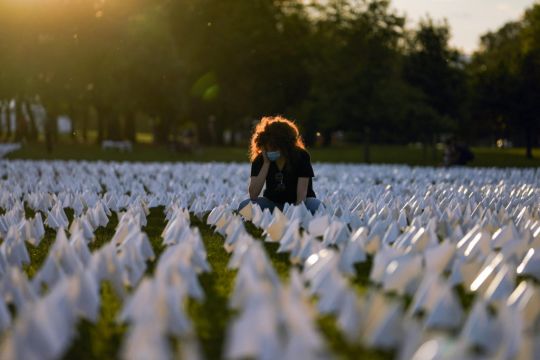The Italian city that suffered the brunt of Covid-19’s first deadly wave is dedicating a vivid memorial to the pandemic dead.
The memorial in Bergamo is a grove of trees, creating oxygen in a park opposite the hospital where so many died, unable to breathe.
The city in northern Italy is among the many communities around the globe dedicating memorials to commemorate lives lost in a pandemic that is nearing the terrible threshold of five million confirmed dead.
Some have been drawn from artists’ ideas or civic group proposals, but others are spontaneous displays of grief and frustration. Everywhere, the task of creating collective memorials is fraught, with the pandemic far from vanquished and new dead still being mourned.

Memorial flags, hearts, ribbons: These simple objects have stood in for virus victims, representing lost lives in eye-catching memorials from London to Washington DC, and Brazil to South Africa.
The collective impact of white flags covering 20 acres on the National Mall in the US capital is breathtaking, representing the more than 740,000 Americans killed by Covid-19, the highest official national death toll in the world.
One honours 80-year-old Carey Alexander Washington, of South Carolina, who was vaccinated and contracted the virus while still working as a clinical psychologist in March.
His six-year-old granddaughter Izzy collapsed in grief when she found her “papa’s” flag – a moment captured by a photographer and shared on Twitter.
“Families like mine, we’re still grieving,” said Mr Washington’s daughter, Tanya, who travelled from Atlanta to see the memorial. “It was important to witness that honour that was being given to them. It gave a voice to all our loved ones that have been lost.”
A memorial wall in London similarly conveys the scale of loss, with pink and red hearts painted by bereaved loved ones on a wall along the River Thames.

Walking the memorial’s length without pausing to read names and inscriptions takes a full nine minutes. The hearts represent the more than 140,000 coronavirus deaths in Britain, Europe’s second highest toll after Russia.
“It shocks people,” said Fran Hall, a spokeswoman for the Covid-19 Bereaved Families for Justice.
She lost her husband, Steve Mead, in September 2020, the day before his 66th birthday.
“Every time we are here, people stop and talk to us, and quite often they are moved to tears as they are walking by, and thank us,” she said.
In Brazil’s capital, relatives of Covid-19 victims planted thousands of white flags in front of Brazil’s Congress in a one-day, emotion-laden action meant to raise awareness of the country’s toll of more than 600,000, the second highest in the world.
And in South Africa, blue and white ribbons are tied to a fence at the St James Presbyterian Church in Bedford Gardens, east of Johannesburg, to remember the country’s 89,000 dead: each blue ribbon counting for 10 lives, white for one.

In India, one of the world’s most affected countries, an online memorial was launched in February, inviting submissions verified with death certificates. So far, it has only 250 tributes, a tiny fraction of the more than 457,000 confirmed dead.
In Russia’s second largest city, St Petersburg, a bronze statue called Sad Angel was placed in March outside a medical school to honour the dozens of doctors and medical workers who died of Covid-19.
The sculpture of an angel with his shoulders slumped and head hanging disconsolately is especially poignant because its creator, Roman Shustrov, himself died of the virus in May 2020.
Italy has not dedicated a national monument to its around 132,000 confirmed dead, but it has designated a coronavirus remembrance day.
Premier Mario Draghi stood among the first newly planted trees in Bergamo’s Trucca Park on March 18, the first anniversary of the indelible image of army trucks bringing dead to other cities for cremation after the city’s morgue was overwhelmed.
Bergamo’s mayor said the city considered proposals for statues or plaques bearing the names of the dead. One was too monumental; the other ignored that so many dead were not officially counted due to a lack of testing.
“The Woods of Memory is a living monument, and it immediately seemed to us to be the most convincing, the most emotive and the one that was closest to our sentiments,” said Bergamo mayor Giorgio Gori.
Only 100 trees have been planted so far of the 700 that are planned. The rest should be planted by next year’s March 18 remembrance day.







